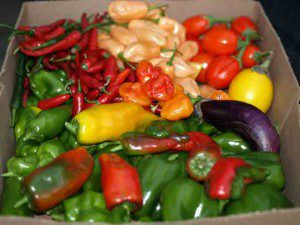Today’s article is a guest post written by Stephen Scott from Terroir Seeds, home of Underwood Gardens and Grandma’s Garden Catalog. Stephen examines the complex relationships between our soil and the food that we eat:
Heirloom seeds and plants, whether they are vegetables, herbs or flowers are more popular than ever now, as more people learn about the amazing taste and scent differences between the supermarket vegetables and home grown ones.
Rising Demand for Local and Home Grown Produce
 People are also realizing there is much more selection and choice in starting plants from seeds than buying seedlings and starts from their local garden centers. On top of this the local food movement is gaining traction and has been growing in double digits for the past 7 to 9 years.
People are also realizing there is much more selection and choice in starting plants from seeds than buying seedlings and starts from their local garden centers. On top of this the local food movement is gaining traction and has been growing in double digits for the past 7 to 9 years.
Local food sources include Farmer’s Markets, Community Supported Agriculture (CSA’s), neighborhood food swaps and buying directly from the farmer at on-farm stands. All of this is great news for people eating healthier and tastier foods than ever before.
One important link in the food chain that is missing, however, is soil and the understanding of creating or growing fertile soil; with all of the benefits that come with healthy soil.
Healthy Soil is Important Far beyond the Confines of the Garden
The best heirloom seeds can only grow to their full potential in healthy, living fertile soil. So what exactly is healthy soil? It is much more than just dirt with some compost and fertilizers mixed in. It is truly living- host to thousands of organisms in many communities that all do different things to provide the most available nutrients and minerals to the plant roots in the soil.
It is in the soil where everything begins. Everything that we need to grow and remain in good health starts with the health of the soil. Dr. Linus Pauling, a two-time Nobel Prize winner stated, “You can trace every sickness, every disease, and every ailment to a mineral deficiency.”
Minerals are the most basic building blocks for nutrition, both in the plants and humans. Without the proper minerals, every other part of the nutritional chain is compromised- nothing else works. Amino acids, enzymes, vitamins and other nutrients are all dependent on minerals.
“Soil Life” is Essential to All Growth and Nutrition
This starts in the plants that we eat, and continues in our bodies. If we want the best benefits from our gardening efforts, we need to build and grow the best, most alive and healthy soil possible. Only then will we be able to grow the best gardens that will in turn give us the best taste and nutrition possible.
The health and vitality of the soil directly affects what the plant can take in, and this impacts what nutrition we receive. For example, a tomato grown in natural, healthy soil will take up 56 minerals! That same tomato can be chemically grown with as few as 7 to 12 minerals, and its taste and nutrition will match.
The interesting thing is that the chemically grown tomato will look good, until it is compared with the naturally grown one. Most fruits and vegetables in the supermarket are commercially grown, which means chemically grown. The true nutrition of the plant depends entirely on the mineral content of the soil.
Plants use the minerals in soil to create vitamins and phytonutrients, or plant created nutrients. What is frightening is that most vegetables that we eat from the supermarket are nutritionally deficient, due to the lack of minerals in the soil where they were grown. This is what industrial chemical agriculture has brought us.
Tomorrow Stephen will return to share a simple shift of mindset that will help immensely to add life and improve your garden’s soil.
Cindy Scott has a degree in greenhouse management, and is the resident grower in the family. She has been collecting articles on soils, seed saving, and general growing for over 10 years. She developed a Grow Native! Plant Sale and Educational Festival that educates gardeners in the Central Arizona Highlands, that is now in its fourth year.
Stephen Scott has a business background and is an acknowledged chili-head who loves the hotter side of things and loves to cook. The appeal of the garden and growing is to supply the freshest ingredients for the meals! He has a large interest in self sustainability- being able to do and produce most of what one needs. They have built a greenhouse from recycled materials that provides year round produce and plants for the garden.



4 Responses
I just read an article recently that touched on the subject of soil in an alternative way. It came in the form of weed control and letting the weeds balance out the soil.
I just read an article recently that touched on the subject of soil in an alternative way. It came in the form of weed control and letting the weeds balance out the soil. Check it out.
http://growyourowngroceries…